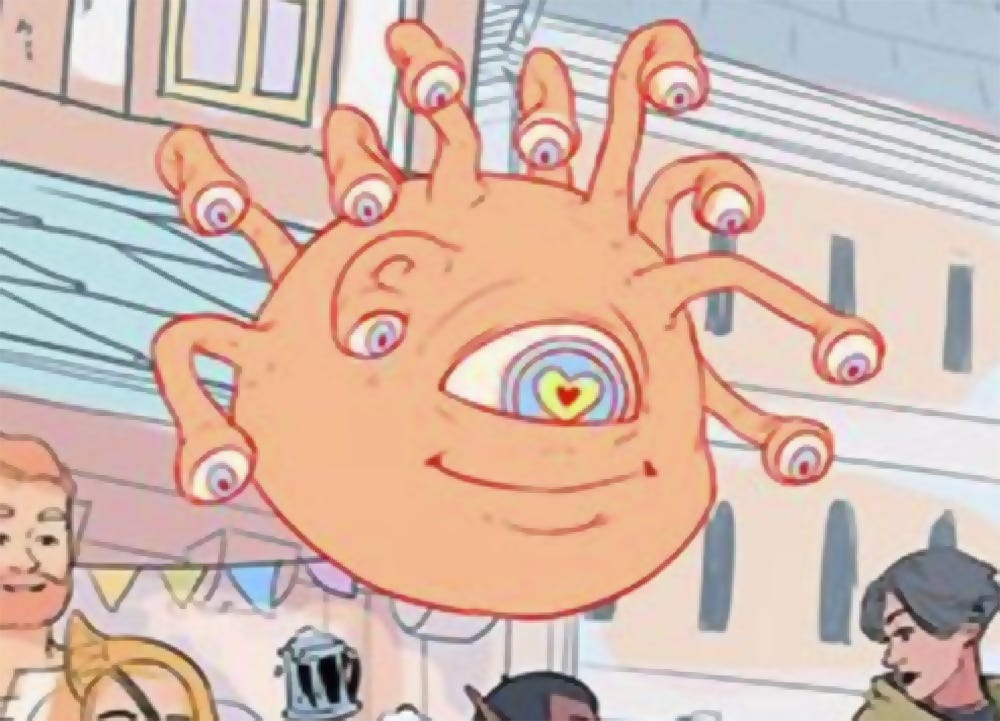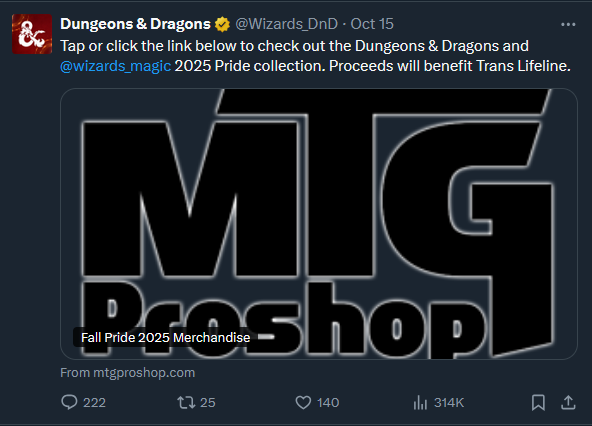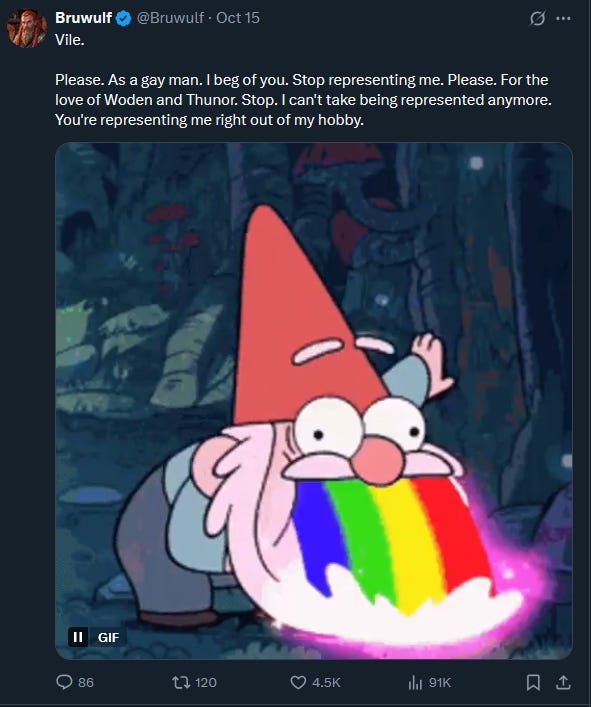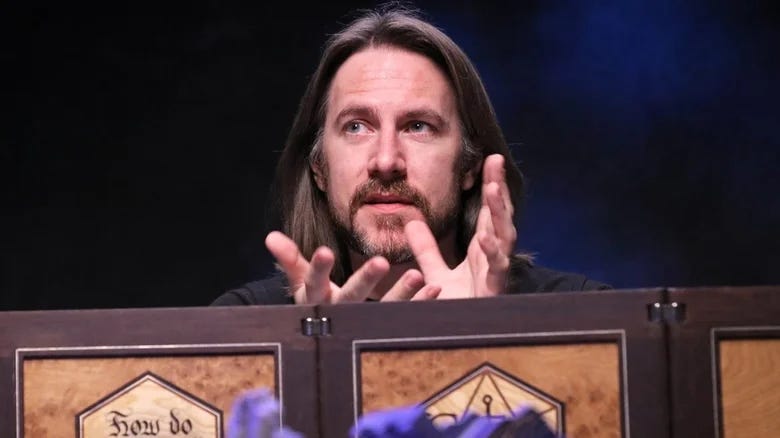Official Dungeons & Dragons Account Posts Very Pastel, Very LGBTQ Artwork and Gets Destroyed by Players on X
The official Dungeons & Dragons X account ignited a firestorm after posting rainbow-soaked, pastel artwork linked to a trans charity—drawing fierce backlash from players who see Wizards of the Coast as straying far from the game’s gritty, dungeon-crawling roots.
Here’s the TL;DR...
Wizards of the Coast shared vibrant art of diverse characters dancing under a pride rainbow with a beholder styled like a Care Bear, tying it to Trans Lifeline donations—and sparking cries of “woke” agenda-pushing over core D&D adventure.
X replies and quote tweets erupted with memes contrasting classic gritty covers against the new “fruity” style, amassing thousands of likes in calls to “rescue” D&D from corporate fluff.
Grognards defend tactical origins against Tumblr-era narrative focus, facing industry scorn where vintage elements offend modern sensitivities.
The Critical Role “Mercer Effect” raises bars for theater-like play, sidelining the raw peril that Gary Gygax built.
Scandals like the 50th anniversary diss of founders, Elon Musk rants, the OGL betrayal, AI art fails, layoffs, and tepid 2024 rules drive fans to Shadowdark and OSR for unfiltered grit.
What Sparked the Massive Backlash on X to Wizards of the Coast’s Latest Artwork?
Wizards of the Coast unleashed a pastel explosion on X with artwork depicting a festive fantasy village where diverse characters twirled through flower petals under a bold rainbow sky.
A beholder floated amid the scene, its central eye mimicking a pride symbol and looking less like a deadly tyrant and more like a Care Bear prepped for hugs instead of hypnosis rays.
The caption teased, “In this realm, your story is yours to tell,” but a follow-up plugged 2025 Pride merch benefiting Trans Lifeline, a crisis support line for transgender people.
To many fans, this blend of whimsy and activism felt like corporate virtue-signaling clashing with D&D’s heritage of high-stakes quests forged by Gary Gygax in the 1970s.
Backlash hit fast as notifications flooded in, with grognards viewing the soft tones as emblematic of broader shifts away from peril and strategy toward feel-good optics. The post landed amid quiet release cycles, amplifying its visibility and echoing Wizards’ post-2020 diversity pushes like lore tweaks for sensitivity, which some hail, but others decry as diluting the game’s escapist edge.
Even the beholder’s redesign irked lore purists. Canonically a paranoid slaver, not a party mascot, critics argued that true inclusivity lies in universal play—not themed art that sidelines monsters’ menace.
How Did Players Express Their Frustration with the “Fruity” Artwork and Trans Charity Link?
Replies turned the thread into an outright roast session.
@BalrogFrog’s side-by-side post of classic vs. new art asking, “How did we go from this, to this?” drew 23,000+ likes.
@MBtheMick mocked the “sanitized” vibe.
@GPrime85 jabbed, “Frank Frazetta is rolling in his grave.”
Quote tweets went nuclear. @J0hnADouglas’s “How it started vs. How it’s going” meme racked up 20,000 likes, while @FBoofis quipped, “D&D was for nerds… now it’s for a single polycule of diaper-fetishist Discord mods in Portland.”
The charity link amplified tension, fueling boycotts. @kekebeke82 wished financial ruin upon Wizards, while others decried activism over adventure. A few defenders spoke up—@ScatterBrainUK replied, “It’s just one picture saying LGBTQ+ folks can be part of it too.”
Hashtags like #SaveDnD trended, memes of “Care Bear beholders” spread, and Reddit and Discord lit up. This wasn’t just art hate—it was a venting point for years of frustration with Wizards’ direction.
Does the Divide Between Old-School Grognards and Tumblr-Era Players Explain the Outrage?
Grognards, named after Napoleon’s stubborn veterans, cling to D&D’s wargame birth in Chainmail battles and lethal delves. They blast modern “softening” for theater kids and wine aunts while enduring progressive scorn where vintage elements offend modern sensibilities.
Early editions demanded survival smarts—torches burned out, traps killed instantly, and strategy mattered more than storytelling. Gygax’s vision prized resourcefulness. Classic art by Larry Elmore screamed danger. The new piece? Petal fluff sans grit.
Modern players, often dubbed the “Tumblr era,” push for diversity representation and narrative focus. They call backlash gatekeeping. Grognards counter that real inclusion was always dice-first, not identity-first.
The fandom schism mirrors culture wars across media—OSR nostalgia vs. modern inclusivity—creating an existential identity crisis for the hobby.
How Has Critical Role and the Mercer Effect Contributed to D&D’s Softening?
Critical Role catapulted D&D into the mainstream through Matthew Mercer’s professional storytelling and ensemble acting. But the so-called Mercer Effect reshaped expectations: casual DMs now feel pressure to deliver cinematic arcs, emotional beats, and voice acting, sidelining gritty tactics.
Grognards argue that this trades tension for theater. Mercer himself warned against mimicry, but Wizards’ marketing leaned into the show’s gloss—chasing accessibility over authenticity.
As one critic put it: “We went from torches and ten-foot poles to trauma arcs and monologues.”
Why Has D&D Faced Accusations of Sexism and Racism Over the Years—and How Fair Are They?
Early D&D reflected 1970s norms. Female stat limits and orc stereotypes mirrored era biases more than malice. Gygax later emphasized freedom and choice, not division.
Post-2020, Wizards rebranded “evil races” and scrubbed certain lore—moves hailed as progress but condemned by grognards as revisionist overreach.
Modern critics see inclusivity as overdue. Veterans view it as erasing history. Both sides claim to defend the soul of the game.
How Did the 50th Anniversary Book Spark Debate Over Original D&D Creators?
The 50th-anniversary book, The Making of Original D&D: 1970–1977, detonated controversy. Writer Jason Tondro’s foreword accused Gygax and Arneson of sexism and racism—judging 1970s creators by 2020s morality.
Rob Kuntz, an original TSR alumnus and Gygax collaborator, called the piece “disgusting slime.” His rebuke went viral among old-school fans.
Even Elon Musk jumped in, tweeting that Wizards should “burn in hell” for “trashing legends.” Amazon ratings tanked amid fan boycotts. For many, this symbolized corporate revisionism trumping respect for history.
What Did Elon Musk Say About Modern D&D Being Lame?
Musk frequently mocks “woke” game design, claiming modern editions have lost “edge and danger.” His posts—often blunt and incendiary—resonate with grognards tired of corporate polish.
“Bring back Gygax. Kill the Care Bears,” one viral reply joked, earning 100K+ likes.
Why Has the 2024 Edition (Often Called 6e) Received Poor Feedback?
The 2024 Player’s Handbook reworks 5e rules for clarity—but many fans dub it “5.5e.” It streamlines play yet removes risk and randomness.
Grognards complain it “codifies fun” at the expense of imagination, while newer players praise accessibility. The divide defines modern D&D discourse: safety rails versus sandbox chaos.
What Was the OGL 1.1 Debacle—and Why Did It Alienate Creators?
The leaked OGL 1.1 in 2023 tried to impose royalties and seize creative control from third-party publishers. Fans revolted. Hashtags like #OpenDnD trended, and Wizards backpedaled.
The damage, though, was permanent. Trust shattered. Indie ecosystems exploded. Games like Shadowdark and Mörk Borg thrived as creators fled corporate oversight.
How Did the AI Art Debacle Damage WotC’s Reputation?
In 2023, fans discovered AI-generated art in Glory of the Giants, breaking Wizards’ own policy. Outrage spread fast. Though patches removed the images, confidence cratered.
Artists condemned WotC’s hypocrisy, arguing the company sacrificed craftsmanship for cost-cutting.
What Impact Have Layoffs Had on Player Confidence?
In 2023, Hasbro axed 1,100 employees, many from Wizards of the Coast. Cuts continued through 2025—even as Baldur’s Gate 3 and D&D’s brand hit mainstream highs.
Fans saw it as proof of corporate greed over community. Combined with rule fatigue and creative drift, layoffs deepened distrust.
Why Are Players Ditching D&D for Systems Like Shadowdark and OSR?
The Old School Renaissance (OSR) and games like Shadowdark resurrect D&D’s lethal charm—resource management, permadeath, and simplicity. They reject both corporate meddling and identity politics.
For disillusioned fans, these systems aren’t just alternatives—they’re redemptions.
Hat Tips
Gizmodo: OGL Debacle – Jan 2023
IGN: AI Art Scandal – May 2024
Forbes: Hasbro Layoffs – Dec 2023
EN World: 2024 Edition & 50th Book – Aug/Nov 2024
Screen Rant: Mercer Effect – Apr 2023
NPR: Diversity in D&D – Jun 2020
EN World: Rob Kuntz on 50th Book – Nov 2024
Substack: OSR Revival – Jan 2024
Article Compiled and Edited by Derek Gibbs on October 16, 2025 for Clownfish TV D/REZZED.








